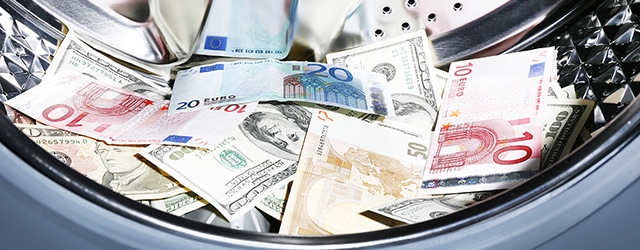The ongoing Danske Bank Estonia scandal has already inspired tighter AML regs in the EU. But the authorities may be only getting started.

The multipronged investigations into money laundering activities on a massive scale at Danske Bank’s Estonia branch (DBE) have triggered a landmark regulatory response from the European Union that is certain to have repercussions for banks in the EU and globally. The DBE scandal is possibly the largest incidence of international money laundering on record. Parent Danske Bank Group’s own estimate suggests that approximately €200 billion ($227.7 billion) may have been laundered through nonresident accounts at DBE between 2007 and 2015.
Pending the outcome of investigations by Danish and Estonian authorities, the European Commission (EC) has promised much tougher anti-money laundering (AML) supervision to reinforce the stability of the banking and financial sector. CFOs and heads of finance at banks doing business in the EU already face a raft of proposed measures that would require financial institutions to strengthen their reporting systems to counter money laundering and terrorist-financing threats. The EC has already issued a printing ban on €500 notes in response to concerns that they have become the legal tender of choice for criminals.
The DBE scandal has exposed clear weaknesses in the EU’s regulation of banks in member countries, and especially of subsidiary branches in smaller, outlying states like Estonia, whose regulators may not have the resources to adequately police and protect the integrity of their banking systems. In the case of Estonia, the risk is thought to emanate from Russia and other former Soviet territories.
While the EU already has strict AML rules in place, the example of Danske Bank shows that rules are not always implemented or effectively enforced, says Valdis Dombrovskis, the EC’s vice president for Euro and social dialogue, financial stability, financial services and the EU’s Capital Markets Union.
Authorities aim to change that. “Anti-money laundering supervision has failed all too often in the EU,” says Dombrovskis in a September 12 EC statement announcing strengthened provisions. “We are enabling the European Banking Authority to make sure that different supervisors cooperate and exchange information and that anti-money laundering rules are enforced effectively across EU countries,” he says.
The EC’s bolstered AML apparatus delivers new powers of supervision to the European Banking Authority (EBA), which “will also be entitled to request investigation into alleged breaches of the rules and will become Europe’s phone number for cooperation with international partners on issues related to combating money laundering in the financial sector,” says Dombrovskis.
“Europe has the strongest anti-money laundering rules in the world, [but] our system is only as strong as our weakest link,” concedes Vra Jourová, the EC’s commissioner for justice consumers and gender equality, in the EC statement.
Flying Under The Radar
More-effective action against money laundering is a mammoth undertaking, not just within the EU but worldwide, given the ease of instant cross-border money transfers in the high-tech age. The rules-based AML system adopted by banks to battle criminal activity is largely toothless against tech-savvy criminal and terrorist organizations that can hire the expertise they need to fly under law enforcement’s radar.
The Basel Institute on Governance’s Basel AML Index for 2018 shows that 83 of 129 countries worldwide have a risk score of at least 5 on a 10-point scale, and not a single country can claim zero risk status. That means the AML systems in most countries carry a “significant risk” and are largely inadequate to deal with sophisticated money laundering and terrorist-financing threats.
“Money laundering and terrorist financing continue to cripple economies, distort international finances and harm citizens around the globe,” according to the Basel Institute. “Estimates of the amount of money laundered worldwide range from $500 billion to a staggering $1 trillion.”
The scope of the EU’s AML challenge is titanic, since millions of dollars can move across borders and change accounts at the click of a mouse. Money laundering has evolved into a highly sophisticated transnational crime. The ongoing DBE probe involves 32 currencies and companies operating in Cyprus, Russia, the British Virgin Islands, the Seychelles, Azerbaijan and Ukraine.
Danish and Estonian investigators suspect that payments from accounts held at DBE went to Latvia, China, Switzerland, Turkey, the UK and more than 150 other countries. In most instances, shell companies were used to disguise the identities of those involved.
Investigators are forensically examining one DBE account connected to Azerbaijani President Ilham Aliyev and his family. The $2.9 billion account may have been used as a slush fund to trade financial inducements to politicians and lobbyists in Europe for their support on Russian and Azerbaijani actions and policy measures.
The scandal has damaged Danske Bank’s reputation in Europe and elsewhere. Denmark’s State Prosecutor for Serious Economic and International Crime has charged Danske with violating the Danish Anti-Money Laundering Act in relation to breaches of rules from 2007 to 2016.
“We did expect to be preliminarily charged,” said Jesper Nielsen, Danske’s head of personal banking and interim CEO, in a November 28 announcement by the bank. He added, “It is in our interest that the case is fully investigated. … In recent years, we have taken a number of [new AML] initiatives, and the situation [at the bank] is now quite different from what it was at the time of the suspicious activities in Estonia.”
The outlook for the bank is not particularly good, however. Denmark’s largest financial group is bracing itself for an avalanche of ML-linked convictions and penalties from both European and US authorities. It has already transferred about $2.7 billion to a capital buffer to absorb potential fines as it deals with the fallout, and may have to add to this as events unfold.
Danske must also address the issue of how over $200 billion could have been laundered through a branch office in Tallinn without either the branch’s managers or the parent’s auditors ringing alarm bells. Former CEO Thomas Borgen was unable to provide the board with solid answers to this question before he resigned on September 19, 2018, when the scandal broke.
Moreover, Borgen struggled to explain why suspicious transactions flagged by whistleblower Howard Wilkinson in 2013 and 2014 were not acted upon more quickly by management. Wilkinson was the head of Danske’s trading unit in the Baltic region from 2007 to 2014.
Between 2007 and 2016, Danske worked at various times with all the big global auditors: Grant Thornton, PwC, KPMG, Deloitte and EY—at a time of mergers among them. The Danish unit of KPMG merged with EY, and that of Grant Thornton with PwC. Throughout this period, these auditors all signed off on DBE’s annual report numbers without raising any concerns.
Neither were alarm bells triggered by DBE’s breathtaking figures—markedly larger than comparable numbers from Danske’s other overseas operations. DBE delivered a return of 402% on allocated capital in 2013 alone: a year when the group’s personal banking business returned 8.7% and its Corporates and Institutions unit reported 10.7%.
Investigators are also exploring Deutsche Bank’s role in processing transfers for Danske. Estimates indicate Deutsche may have cleared about $150 billion for DBE over the four years to 2015, most of the money originating with private clients of DBE located in Russia and the former Soviet Union.
The first arrests in the DBE case, of 10 former Danske Bank employees, were made by Estonian police in December. The police, working with the Office of the Prosecutor General (OPG), commissioned audits of 15,000 private and corporate nonresident accounts held with DBE from 2007 to 2015. The OPG described around 6,200 of these accounts as “suspicious.”
However, the OPG’s investigation is hampered by a lack of cooperation from authorities in Russia, says Lavly Perling, Estonia’s prosecutor general. “Collaboration from Denmark has been good; but obtaining cooperation and, most importantly, getting information from Russia relevant to our case inquiries continues to be difficult.”



